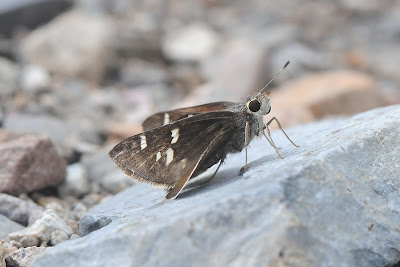After Arizona, we headed west into California and up into Oregon and Washington. Although we didn't have a lot of time to work bugs, I took a lot of pictures of what I could find.
Starting in California, we had some luck with butterflies at the San Elijo Lagoon which is north of San Diego. It was there that we saw:
Lorquin's Admiral:
Fatal Metalmark:
The MARINE BLUES continued to be abundant:
Gray Hairstreaks apparently occur here as well:
We eventually got up into Oregon for a quick trip through northward. I pulled my camera out at a rest area along the interstate and came away with pictures of this COMMON RINGLET:
... and this PINE WHITE:
Later on that day, I ventured outside again for bflies and found this pair of SACHEMS:
I think it was the next day that we took a stroll near Eugene, Oregon and stumbled on things like this WESTERN TAILED-BLUE:
From what I can tell, WOODLAND SKIPPERS are perhaps the most abundant grass skipper during this season in Washington:
It's clear that this WESTERN TIGER-SWALLOWTAIL had seen better days:
We spent a brief day at Mount Rainier and saw things like this SILVER-BORDERED FRITILLARY:
There were a LOT of checkerspots/crescents around. I'm not totally convinced that these four photos are all VARIABLE CHECKERSPOTS but a part of me thinks so. Thoughts?

There were also some blues around up in the higher elevation including this MELISSA BLUE:
... and this BOISDUVAL'S BLUE:
I'll close with a butterfly in Sacramento that stumped me. There aren't THAT many skippers possible here this time of year and with this butterfly being so worn, I wonder if it's just a SACHEM?
The next post will be devoted to some of the dragonflies/damselflies from our AZ/CA/OR/WA trip. Stay tuned...




















































